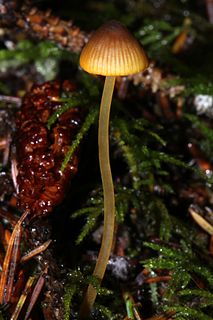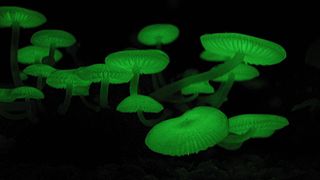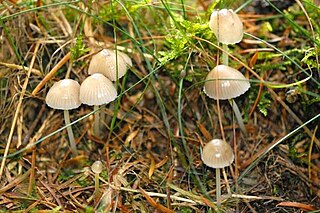
Roridomyces roridus, commonly known as the dripping bonnet or the slippery mycena, is a species of agaric fungus in the family Mycenaceae. It is whitish or dirty yellow in color, with a broad convex cap 5–15 mm (0.2–0.6 in) in diameter. The stipe is covered with a thick, slippery slime layer. This species can be bioluminescent, and is one of the several causative species of foxfire.

Mycena stylobates, commonly known as the bulbous bonnet, is a species of inedible mushroom in the family Mycenaceae. Found in North America and Europe, it produces small whitish to gray fruit bodies with bell-shaped caps that are up to 15 mm (0.6 in) in diameter. The distinguishing characteristic of the mushroom is the fragile stipe, which is seated on a flat disk marked with distinct grooves, and fringed with a row of bristles. The mushrooms grow in small troops on leaves and other debris of deciduous and coniferous trees. The mushroom's spores are white in deposit, smooth, and ellipsoid-shaped with dimensions of 6–10 by 3.5–4.5 μm. In the development of the fruit body, the preliminary stipe and cap structures appear at the same time within the primordium, and hyphae originating from the stipe form a cover over the developing structures. The mycelia of the mushroom is believed to have bioluminescent properties.

Mycena maculata, commonly known as the reddish-spotted Mycena, is a species of fungus in the Mycenaceae family. The fruit bodies, or mushrooms, have conic to bell-shaped to convex caps that are initially dark brown but fade to brownish-gray when young, reaching diameters of up to 4 cm (1.6 in). They are typically wrinkled or somewhat grooved, and have reddish-brown spots in age, or after being cut or bruised. The whitish to pale gray gills also become spotted reddish-brown as they mature. The stem, up to 8 cm (3.1 in) long and covered with whitish hairs at its base, can also develop reddish stains. The mycelium of M. maculata has bioluminescent properties. The saprobic fungus is found in Europe and North America, where it grows in groups or clusters on the rotting wood of both hardwoods and conifers. The edibility of the fungus is unknown. Although the species is known for, and named after its propensity to stain reddish, occasionally these stains do not appear, making it virtually indistinguishable from M. galericulata.

Mycena aurantiomarginata, commonly known as the golden-edge bonnet, is a species of agaric fungus in the family Mycenaceae. First formally described in 1803, it was given its current name in 1872. Widely distributed, it is common in Europe and North America, and has also been collected in North Africa, Central America, and Japan. The fungus is saprobic, and produces fruit bodies (mushrooms) that grow on the floor of coniferous forests. The mushrooms have a bell-shaped to conical cap up to 2 cm (0.8 in) in diameter, set atop a slender stipe up to 6 cm (2.4 in) long with yellow to orange hairs at the base. The fungus is named after its characteristic bright orange gill edges. A microscopic characteristic is the club-shaped cystidia that are covered with numerous spiky projections, resembling a mace. The edibility of the mushroom has not been determined. M. aurantiomarginata can be distinguished from similar Mycena species by differences in size, color, and substrate. A 2010 publication reported the discovery and characterization of a novel pigment named mycenaaurin A, isolated from the mushroom. The pigment is responsible for its color, and it has antibiotic activity that may function to prevent certain bacteria from growing on the mushroom.

Mycena chlorophos is a species of agaric fungus in the family Mycenaceae. First described in 1860, the fungus is found in subtropical Asia, including Japan, Taiwan, Polynesia, Indonesia, and Sri Lanka, in Australia, and Brazil. Fruit bodies (mushrooms) have pale brownish-grey sticky caps up to 30 mm (1.2 in) in diameter atop stems 6–30 mm (0.2–1.2 in) long and up to a millimeter thick. The mushrooms are bioluminescent and emit a pale green light. Fruiting occurs in forests on fallen woody debris such as dead twigs, branches, and logs. The fungus can be made to grow and fruit in laboratory conditions, and the growth conditions affecting bioluminescence have been investigated.
Mycena asterina is a species of agaric fungus in the family Mycenaceae. It is found in São Paulo state, Brazil, where it grows singly or scattered on fallen leaves in Atlantic forests. The fruit bodies of the fungus are bioluminescent.
Mycena discobasis is a species of agaric fungus in the family Mycenaceae. Found in South America and Madagascar, the fruit bodies of the fungus are bioluminescent.
Mycena fera is a species of agaric fungus in the family Mycenaceae. Found in South America, the fruit bodies of the fungus are bioluminescent.
Mycena lacrimans is a species of agaric fungus in the family Mycenaceae. Found in South America, the fruit bodies of the fungus are bioluminescent.
Mycena illuminans is a species of agaric fungus in the family Mycenaceae. It is bioluminescent.

Mycena zephirus is a species of agaric fungus in the family Mycenaceae. It is bioluminescent.
Mycena sublucens is a species of agaric fungus in the family Mycenaceae. Found in Indonesia, it was described as new to science in 1954 by English mycologist E. J. H. Corner. The fruit bodies are bioluminescent.

Mycena singeri is a species of agaric fungus in the family Mycenaceae. Described as new to science in 1988, it is bioluminescent.
Mycena pseudostylobates is a species of agaric fungus in the family Mycenaceae. It is bioluminescent.

Mycena olivaceomarginata is a species of agaric fungus in the family Mycenaceae. Originally described as Agaricus olivaceomarginata by English mycologist George Edward Massee in 1890, he transferred it to Mycena in 1893. Found in Europe and North America, the mycelium of the fungus is bioluminescent.
Mycena noctilucens is a species of agaric fungus in the family Mycenaceae. The species was first described scientifically by E.J.H. Corner in 1954. Found in Malaysia and the Pacific islands, the mycelium of the fungus is bioluminescent.

Mycena manipularis is a species of agaric fungus in the family Mycenaceae. Found in Australasia, Malaysia, and the Pacific islands, the mycelium and fruit bodies of the fungus are bioluminescent.
Roridomyces irritans is a species of fungus in the genus Roridomyces, family Mycenaceae. Originally described from New Caledonia as Mycena irritans by Egon Horak in 1978, the species was transferred to Roridomyces in 1994. The fruit bodies are bioluminescent.












